"Roll Your Own" Stratux ADS-B Receiver Test
- Details
- Written by Kevin Horton
- Hits: 5790
I got back yesterday afternoon from three weeks in Wichita, doing CSeries flight testing.
While I was in Wichita, I bought the parts to cobble together a cheap open-source ADS-B In receiver (part 2), based on a Raspberry Pi computer and two software defined radios. ADS-B In is widely used in the US to transmit weather info and traffic to suitably equipped aircraft. It would be quite useful when flying in US airspace, and possibly useful when in Canadian airspace (see ADS-B Primer).
Today I took the ADS-B receiver flying, to see how it worked. The receiver I assembled emulates the popular Appareo Stratus ADS-B receiver, so it is compatible with any device that can receive signals from such a receiver. I used ForeFlight on my iPad mini to receive and display the data.
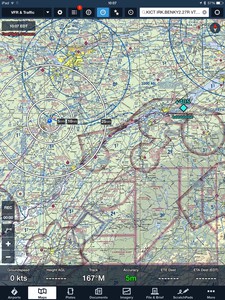 It was receiving transmissions from high flying aircraft on 1090 MHz when I fired it up on the ground. The cyan diamond represents the aircraft that was being received, and “+405” above the diamond means the aircraft was 40,500 ft higher than my aircraft, or 41,000 ft above sea level (Smiths Falls is just over 400 ft elevation).
It was receiving transmissions from high flying aircraft on 1090 MHz when I fired it up on the ground. The cyan diamond represents the aircraft that was being received, and “+405” above the diamond means the aircraft was 40,500 ft higher than my aircraft, or 41,000 ft above sea level (Smiths Falls is just over 400 ft elevation).
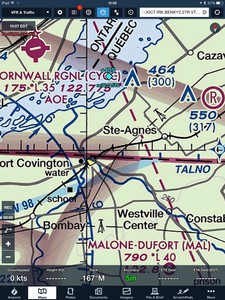 I zoomed in on the traffic awhile later, and saw the call sign below the diamond (“WJA518”, or West Jet 518).
I zoomed in on the traffic awhile later, and saw the call sign below the diamond (“WJA518”, or West Jet 518).
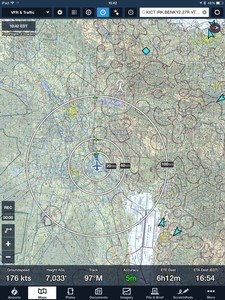 Level at 7500 ft, I was picking up signals from two ground stations. The ground station locations are shown the map with a while tower symbol.
Level at 7500 ft, I was picking up signals from two ground stations. The ground station locations are shown the map with a while tower symbol.
 The system had local and national radar and weather reports and forecasts for US airports.
The system had local and national radar and weather reports and forecasts for US airports.
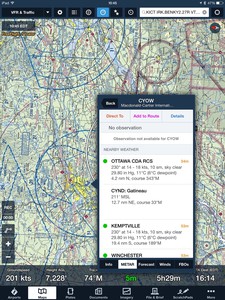 There wasn’t any data for Canadian airports, but there were weather reports for numerous non-aviation reporting stations in Canada.
There wasn’t any data for Canadian airports, but there were weather reports for numerous non-aviation reporting stations in Canada.
I had tested the system in Kansas, using the ground station at Newton, and it was receiving forecasts for Canadian airports. I’m not sure what the transmission interval is for the various data types. Maybe the Canadian forecast data would have arrived if I waited longer. In any event, airport weather reports are much more important than weather forecasts, and I saw no sign of those on either of these two tests.
If I was only flying in the US, it would be a no-brainer to stop spending $60/month on XM, but ADS-B probably isn't good enough to replace XM in Canada, as it has no Canadian radar data, and precious little other weather data. I'll use both ADS-B and XM Weather next summer, and then decide if ADS-B is good enough to stop subscribing to XM.
Glide Performance at Idle
- Details
- Written by Kevin Horton
- Hits: 6713
A long time ago, I did glide performance testing, with the engine off and the prop windmilling. A week ago I finally did glide performance testing with the engine at idle, to see how much of a difference there was.
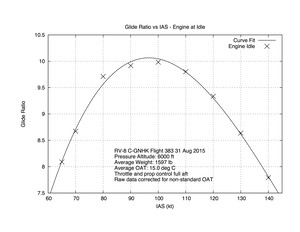 Both sets of testing were done at 1600 lb weight. The best glide speed with the engine at idle was about 96 kt, and the glide ratio was about 10.1:1.
Both sets of testing were done at 1600 lb weight. The best glide speed with the engine at idle was about 96 kt, and the glide ratio was about 10.1:1.
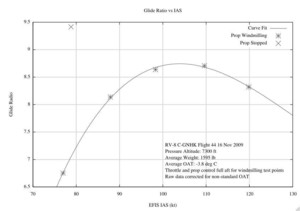 The best glide speed with engine off was about 104 kt, and the glide ratio was about 8.75:1.
The best glide speed with engine off was about 104 kt, and the glide ratio was about 8.75:1.
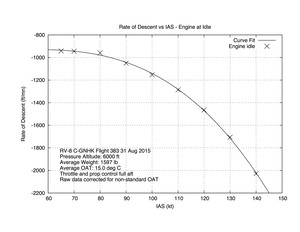 The speed for minimum rate of descent was about 65 kt with engine at idle.
The speed for minimum rate of descent was about 65 kt with engine at idle.
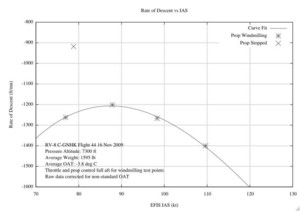 The speed for minimum rate of descent was about 88 kt with engine off.
The speed for minimum rate of descent was about 88 kt with engine off.
Most builders conduct their glide testing with the engine at idle, but my results suggest that this gives a false impression of the speed for best glide and the glide ratio. In my case, the glide ratio is about 15% worse with the engine off, and the best glide speed is about 8 kt faster.
Race the Runway 2015
- Details
- Written by Kevin Horton
- Hits: 3843
I would have liked to go flying today, but the airport was closed for the annual Race the Runway event, the biggest fund-raiser of the year. The airport needs the income to pay the bills, so I won’t complain.
The Race the Runway event allows Street-legal cars and motorcycles run a 1/2 mile course laid out on the 4,000 ft long runway. I was on parking duty from 0800 to 1400, so althougth I heard the sounds of the runs down the runway, I didn’t see much.
The top speeds for the four years the event has run are:
| Year | Car | hp | 1/2 mile Speed (km/h) | 1/2 mile Speed (mph) |
|---|---|---|---|---|
| 2012 | Porsche 911 Turbo | 258 | 160 | |
| 2013 | Lamborghini Aventador | 258 | 160 | |
| 2014 | Lamborghini Super Trofeo Stradal | 2000 | 330 | 205 |
| 2015 | Acura NSX | 890 | 277 | 172 |
The 330 km/h Lamborghini ran off the end of the runway at the end of his last run in 2014 - he didn’t come back this year. The runway is only 4000 ft long, so 50 ft lost at the start before the timing starts, and the 1/2 mile acceleration only leaves 1310 ft for braking. If the driver has a 1/2 second reaction time after passing the 1/2 mile mark, he would need a deceleration of about 1.2g to get stopped - he got stopped after his first 330 km/h run, but not the second one.
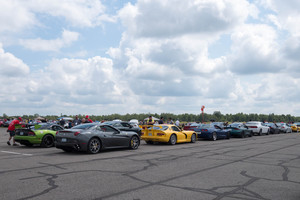 Here we see a long line of cars, waiting for their turn on the runway.
Here we see a long line of cars, waiting for their turn on the runway.
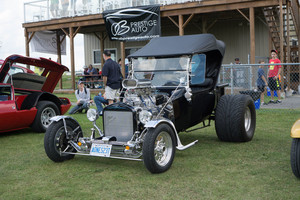 There were also quite a few of show cars on display, including this gorgoeus Ford Model T street rod.
There were also quite a few of show cars on display, including this gorgoeus Ford Model T street rod.
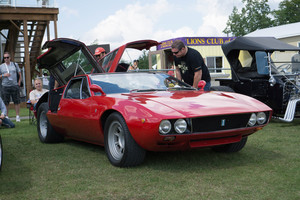 This rare De Tomaso Mangusta attracted quite a bit of attention.
This rare De Tomaso Mangusta attracted quite a bit of attention.
 The Carleton University Formula SAE team was there, with their two cars - one powered by a 250 cc single-cylinder engine, and the other one electric powered.
The Carleton University Formula SAE team was there, with their two cars - one powered by a 250 cc single-cylinder engine, and the other one electric powered.
Bromont, QC for Lunch
- Details
- Written by Kevin Horton
- Hits: 4816
Yesterday was forecast to be another beautiful day, so Terry and I decided to fly to Bromont, QC for lunch. We had never been there before in the RV–8, but the new restaurant in the airport terminal building had very good reviews, so off we went.
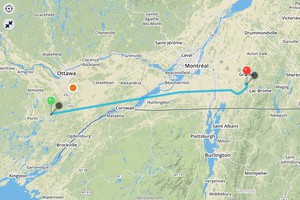 Bromont does not report weather, but it is in between Montreal and Sherbrooke. The weather in the morning was great in the Ottawa area, but Montreal was unexpectedly overcast at 700 ft, but forecast to improve mid-morning. Sherbrooke was clear. The Bromont weather was anyone’s guess. Fortunately we can fly Instrument Flight Rules (IFR) - i.e. I can legally fly in cloud, so the possible poor weather was not a significant concern, as long as we had enough fuel to fly to an alternate airport with good weather, just in case the weather at Bromont turned out to be too poor to land.
Bromont does not report weather, but it is in between Montreal and Sherbrooke. The weather in the morning was great in the Ottawa area, but Montreal was unexpectedly overcast at 700 ft, but forecast to improve mid-morning. Sherbrooke was clear. The Bromont weather was anyone’s guess. Fortunately we can fly Instrument Flight Rules (IFR) - i.e. I can legally fly in cloud, so the possible poor weather was not a significant concern, as long as we had enough fuel to fly to an alternate airport with good weather, just in case the weather at Bromont turned out to be too poor to land.
We flew towards Bromont at 7,000 ft altitude, and could see the low overcast cloud below as we approached Montreal. We started to fly the instrument approach into Bromont, but the low clouds disappeared when we were about 15 miles from the airport, so we switched to flying visually and landed.
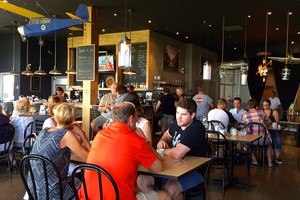 The airport restaurant, Bistro M, was extremely busy. It looked to be all local non-aviation people, except for us and the crew of the Challenger business jet who landed shortly after we did. The food was excellent - we will go back.
The airport restaurant, Bistro M, was extremely busy. It looked to be all local non-aviation people, except for us and the crew of the Challenger business jet who landed shortly after we did. The food was excellent - we will go back.
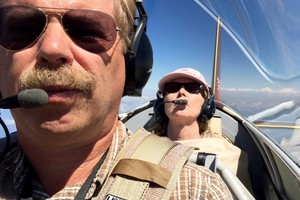 Terry was a bit tired after the tasty lunch, so she snoozed on the way home.
Terry was a bit tired after the tasty lunch, so she snoozed on the way home.
Oil Change and Oil Drain Valve Replacement
- Details
- Written by Kevin Horton
- Hits: 3825
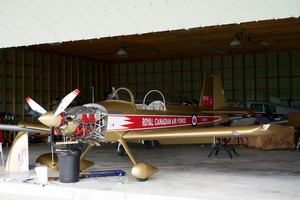 Yesterday morning I did a short flight to warm the oil, then drained the oil and changed the oil filter. While the oil was out, I attacked the leaky oil quick drain valve. I had installed a cheap quick drain valve many years ago, but noticed that it was leaking earlier this year. The Curtiss drain valve I had installed was not rebuildable, so I bought a more expensive Saf-Air P5000 drain valve.
Yesterday morning I did a short flight to warm the oil, then drained the oil and changed the oil filter. While the oil was out, I attacked the leaky oil quick drain valve. I had installed a cheap quick drain valve many years ago, but noticed that it was leaking earlier this year. The Curtiss drain valve I had installed was not rebuildable, so I bought a more expensive Saf-Air P5000 drain valve.
 Removing the old oil drain valve was a much bigger job than I had expected. I had to remove a heat muff and detach an intake tube so I could have enough clearance to get a wrench on the valve. But, I couldn’t get it to turn before the open end wrench started to flex and threaten to round off the hex flats. Drat.
Removing the old oil drain valve was a much bigger job than I had expected. I had to remove a heat muff and detach an intake tube so I could have enough clearance to get a wrench on the valve. But, I couldn’t get it to turn before the open end wrench started to flex and threaten to round off the hex flats. Drat.
I couldn’t use a box wrench or a socket as the valve had two tangs sticking out. I had to cut off the tangs and file down the ends so I could get a long reach six point socket on it. That allowed me to get enough torque on it to unscrew it.
At Oshkosh 2015
- Details
- Written by Kevin Horton
- Hits: 4180
I had difficulties uploading items to the web site for a few days, but Arvixe got that sorted out today. So, here is the details of the time at Oshkosh.
This year’s EAA Fly-In at Oshkosh had probably the best weather I have ever had in any of my 20 or so visits since the early 90’s. It was warm, but not too hot and muggy, and it cooled off nicely at night so sleeping in a tent wasn’t a miserable, sweaty experience. There were no thunderstorms the whole time we were there (there was a nasty one early Saturday morning, two days before the show started). No rain. No mud. There was enough breeze in the evenings to keep the mosquitos at bay, except for Wednesday evening, which was the night air show.
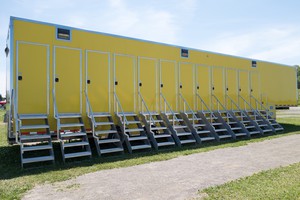 HomeBuilt Camping finally got a much needed upgrade to the shower facilities. They brought in two semi-trailer size portable shower units, each with 12 shower individual showers.
HomeBuilt Camping finally got a much needed upgrade to the shower facilities. They brought in two semi-trailer size portable shower units, each with 12 shower individual showers.
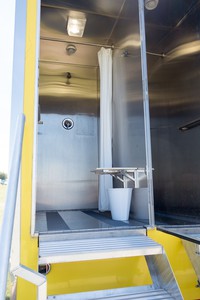 Each shower room had a change area, and a shower area.
Each shower room had a change area, and a shower area.
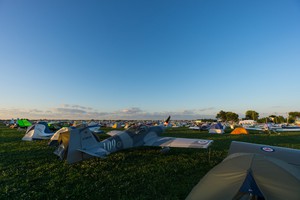 We were camped next to Tom Martin’s smoking fast F–1 EVO Rocket. Tom has spent hundreds of hours making aerodynamic cleanup mods to improve his performance in the Sport Air Racing League. It was very instructive to study the various mods he has done to his aircraft.
We were camped next to Tom Martin’s smoking fast F–1 EVO Rocket. Tom has spent hundreds of hours making aerodynamic cleanup mods to improve his performance in the Sport Air Racing League. It was very instructive to study the various mods he has done to his aircraft.
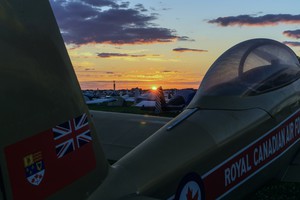 Sleeping in a tent probably means you wake up as soon as the day starts to break. Wednesday AM, I peeked out of the tent to see the start of a lovely sunrise, so I quickly got dressed and put the camera on the tripod, hoping to get a good shot.
Sleeping in a tent probably means you wake up as soon as the day starts to break. Wednesday AM, I peeked out of the tent to see the start of a lovely sunrise, so I quickly got dressed and put the camera on the tripod, hoping to get a good shot.
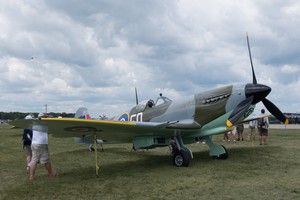 The nose of this “Spitfire” looked slightly off to me, so I took a closer look. I was very surprised to see no rivets. It is a 100% scale, Jurca MJ–100 Spitfire replica, with a 1300 hp Allison V–1710. This gorgeous aircraft won a bronze Lindy award for outstanding plans-built aircraft.
The nose of this “Spitfire” looked slightly off to me, so I took a closer look. I was very surprised to see no rivets. It is a 100% scale, Jurca MJ–100 Spitfire replica, with a 1300 hp Allison V–1710. This gorgeous aircraft won a bronze Lindy award for outstanding plans-built aircraft.
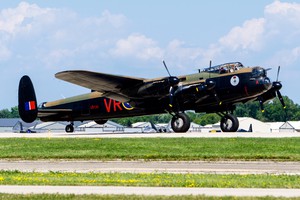 The afternoon airshow has a different lineup every day. Thursday had a heavier focus on warbirds, so I made a point of getting a front row spot to watch. The Canadian Warplane Heritage Lancaster looked great.
The afternoon airshow has a different lineup every day. Thursday had a heavier focus on warbirds, so I made a point of getting a front row spot to watch. The Canadian Warplane Heritage Lancaster looked great.
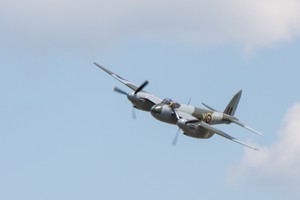 The Military Aviation Museum’s Mosquito sounded fabulous.
The Military Aviation Museum’s Mosquito sounded fabulous.
 The 20 T–6 Texans (aka Harvard) pilots had obviously spent quite a bit of time practicing their formation flying, as all five four-ship sections looked very sharp.
The 20 T–6 Texans (aka Harvard) pilots had obviously spent quite a bit of time practicing their formation flying, as all five four-ship sections looked very sharp.
